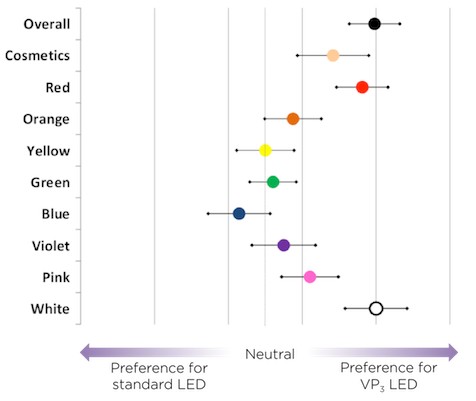Soraa CTO Mike Krames explores the importance of color rendering for LEDs in this recent blog entry.
The Illumination Engineering Society (IES) recently published a “position statement” (PS-8-14) which states that color rendering “requirements should not be a metric used in energy regulations to characterize color attributes for solid state lighting.” This unfortunate wording has caused unnecessary headaches within the lighting community, but what the well-intentioned IES meant to say was that the commonly used Color Rendering Index (CRI) metric is not entirely adequate and a replacement is warranted. We fully agree and are actively engaged with IES to improve this metric, but by no means should color rendering requirements be put on the sidelines while we all wait for improvements!
Through our collaboration with Penn State University (PSU), we have already shown that color perception really breaks along two dimensions: fidelity (color accuracy) and gamut (color preference). In the past these have often been mixed up, or not controlled against one another, leading observers to make strange statements such as “I preferred the low CRI lamp” which are simply out of context and misleading.
In our most recent work with PSU, we chose two LED light sources of similar gamut, but distinctly different fidelity (blue-based LED with CRI of 85 vs. violet-based LED of CRI 97), and compared subject preference for object illumination in carefully controlled psychophysical experiments. The results are crystal clear. Subjects strongly preferred colors (especially warm tones, including their own skin color) and gave a higher overall preference and naturalness rating to the higher CRI light source. At least as, if not more, dramatic was the perception of white objects (especially subjects’ own teeth!) which were properly rendered by the violet-based LED (a full spectrum light source) and not by the blue-based LED, which is missing emission in the violet wavelength regime. (See more on Whiteness Rendering here.) The funny aspect of this outcome is that, while we wait for an improved color fidelity metric, the industry does not even have a metric on whiteness rendering!
The good news is that IES is beginning to look at whiteness, too, and improved understanding and metrics are on their way for both color and whiteness rendering, and will be revealed in the fullness of time. Importantly however, end users like me and you really do not need to wait for industry-ratified metrics to enjoy quality-of-life aspects along with energy efficient lighting: it exists already today in Soraa’s products with VP₃ Natural White and VP₃ Vivid Color technology.
Don’t be fooled. There is no need to wait. Simply, enjoy.
 |
|
(Source: Soraa) |












